2010/11 Scottish Crime and Justice Survey: Drug Use
This report presents findings from the Scottish Crime and Justice Survey 2010/11 Drug Use module. The report provides information on the experience and prevalence of illicit drug use amongst the general adult population in Scotland.
3 The Experience of Adults Reporting Drug Use
Drug most commonly reported
Cannabis was the drug most commonly reported. Of those who had used an illicit drug in the last year, 83.6% reported using cannabis in that time. 87.2% of those using any illicit drug in the last month reported using cannabis in the last month.
Frequency of drug use
Of those who had used drugs in the last month, half (49.1%) had used their only / most frequently used drug on at least a weekly basis, including around a quarter (24.3%) who reported use every day or almost every day.
Dependency on drugs
Of those who had used an illicit drug in the last month, almost a quarter (24.4%) reported feeling dependent on the drug they used most often in the last month. Three in ten (29.7%) said they had tried to cut down, but found they could not, on their use of the drug they used most often in the last month. 12.7% reported both feeling dependent and trying to cut down, but finding they could not, on the drug they used most often in the last month.
Ease of obtaining drugs
In 2010/11, fewer respondents reported finding it very easy to obtain the drug they most commonly used in the last month compared to 2008/09, while more respondents reported that it was fairly difficult to obtain the drug.
Polydrug use / mixing alcohol and drugs
Of those who had used at least one illicit drug in the last month, 34.3% reported some kind of polydrug use and 84.6% reported drinking alcohol at some point in their lives while taking the drug they had used most often in the last month.
First drug use
Of the 23.7% of adults who had ever used illicit drugs, over half (51.3%) reported that they had first tried them when they were in their late teens (16-19 years), whilst a quarter (24.7%) first tried them when they were under 16 years.
Reflecting its dominance, cannabis was the first drug tried by more than three quarters (78.3%) of adults who reported that they had used an illicit drug at some point in their lives.
This chapter takes a more detailed look at the experiences of adults who reported illicit drug use in the last year and the last month.
Initially it examines drug use in the last year and in the last month by individual drug.
The chapter then moves on to look at more detailed experiences of drug use in the last month, including drugs used, frequency of use, levels of dependency, ease of obtaining drugs, polydrug use and the use of alcohol at the same time.
The chapter concludes by looking at first experiences and methods of taking drugs.
3.3 Self-reported drug use in the last year
As discussed in Chapter 2, almost a quarter (23.7%) of adults in Scotland reported they had used drugs at some point in their lives. This section focuses on the experience of these adults. Of these, almost three in ten (27.8%) reported using at least one drug in the last year. Figure 3.1 examines the individual drugs taken in the last year based on those who had taken at least one drug in that period. The figure is ranked in order of drugs ever used:
- More than eight in ten (83.6%) adults who had used any illicit drug in the last year had used cannabis in that time;
- Over two in five (41.9%) of those who had used any illicit drug in the last year had used a stimulant in that time period. This included 27.8% who had taken cocaine in the last year, 20.7% who had taken ecstasy, 13.8% amphetamines, 9.4% poppers, 2.0% crack and 0.1% who had taken crystal meth in the last year;
- Of those adults who had taken any drug in the last year, 16.6% had taken downers / tranquilisers in the last year including 15.1% who had taken valium and 4.2% who had taken temazepam;
- Almost one in ten (9.3%) of those who had used any illicit drug in the last year had used one or more psychedelic drug, including 5.0% who had taken magic mushrooms, 4.0% had taken ketamine and 3.3% who reported taking LSD in the last year;
- 3.9% of those who had used any illicit drug in the last year had taken an opiate in that time period. This included 3.0% who had taken heroin and 2.7% who had taken methadone illicitly in the last year;
- 2.8% of those using any illicit drug in the last year had used glues, solvents, gas or aerosols and 0.9% had used anabolic steroids in that period.
Figure 3.1: % of adults aged 16 or over who had used each illicit drug in the last year
SCJS 2010/11.
Base: Adults aged 16 or over who had used at least one illicit drug in the last year (574).
Variable name: Q12M.
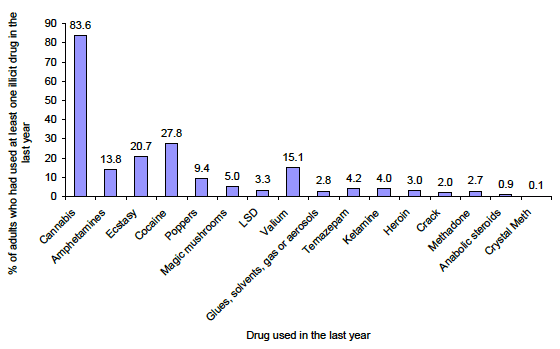
3.4 Self-reported drug use in the last month
Chapter 2 identified that around one in twenty nine (3.5%) adults aged 16 or over reported using one or more illicit drug in the last month. Figure 3.2 shows use of individual drugs in the last month as a percentage of those who had used at least one drug in the last month to give a relative indication of the most commonly used drugs. The figure is ranked in order of drugs ever used:
- Almost nine in ten (87.2%) adults who had used any illicit drug in the last month reported that they had used cannabis in that time period;
- A third (33.4%) of those who had used any illicit drug in the last month reported stimulant use in that time period. This included 19.9% who had taken cocaine in the last month, 16.3% who had taken ecstasy in the last month, 11.2% amphetamines, 5.2% poppers and 1.6% crack;
- Of those who had taken any drug in the last month, 11.8% reported that they had taken downers / tranquilisers in that period including 11.0% who had taken valium and 3.9% who had taken temazepam;
- Of those who had used any illicit drug in the last month 6.2% had used a psychedelic drug in that period, including 3.4% who had taken LSD, 3.4% who had taken magic mushrooms and 1.9% who had taken ketamine in the last month;
- 6.5% of those who had used any illicit drug in the last month had taken an opiate in that time period. This included 4.8% who had taken methadone and 3.7% who had taken heroin in the last month;
- 1.0% of those using any illicit drug in the last month had used glues, solvents, gas or aerosols and 0.9% had used anabolic steroids in the last month.
Figure 3.2: % of adults aged 16 or over who had used each illicit drug in the last month
SCJS 2010/11.
Base: Adults aged 16 or over who had used at least one illicit drug in the last month (308).
Variable name: Q1M.
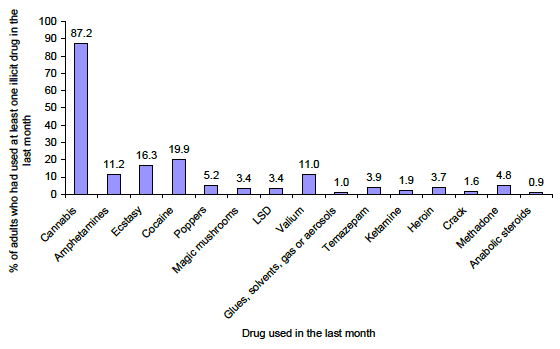
3.5 Experience of drug use in last month
Self-reported use of illicit drugs in the last month provides information on drugs taken in the most recent time period covered by the SCJS 2010/11. This section looks at the single illicit drug reported as being used / used most often in the month prior to interview, the frequency with which that drug was used and adults' perception of their dependency on that drug.[26] The ease of obtaining the drug used most often in the last month and use of additional drugs (polydrug use) or alcohol alongside the most frequently used drug is also examined.
The single drug reported as being used most often in the last month extended across a range of drugs though cannabis was identified as the most dominant:
- Of those who had used any drug in the last month, four in five (80.2%) reported cannabis as the drug they had taken most often in that period;
- One in eight (12.5%) of those using drugs during the last month identified a stimulant as their most frequently used drug:
- 6.0% reported cocaine as the drug they used most often in the last month, the highest percentage after cannabis;
- Other stimulants reported as being most used in the last month included ecstasy (3.4%) amphetamines (1.1%), poppers (1.6%), and crack (0.3%). No adults reported crystal meth as the drug they used most often in the last month;
- Fewer adults (1.9%) used a drug from the composite group of downers / tranquilisers as the drug they had used most often in the last month:
- A higher percentage identified valium (1.6%) than temazepam (0.3%) as the drug they took most often in the last month;
- 0.8% of adults reported a drug from the composite group psychedelics as the illicit drug used most often in the last month. This included ketamine (0.5%) and LSD (0.3%). No adults reported that they had used magic mushrooms as the drug they used most often in the last month;
- Opiates were used most often in the last month by 2.6% of those who had used any illicit drug in that period including methadone (1.6%) and heroin (1.0%);
- Less than one per cent of those using any illicit drug in the last month had used anabolic steroids (0.7%) or glues, solvents, gas or aerosols (0.2%) most often in the last month;
- Among Class of drugs, 12.6% of adults reporting use of any illicit drug in the last month reported a Class A drug as the drug they had used most often in the last month, 81.3% reported a Class B drug and 3.0% a Class C drug.
3.5.1 Drug used most often in last month - frequency of use
Of the 3.5% of adults who had used drugs in the last month, half (49.1%) had used their most frequently used drug on at least a weekly basis, including around a quarter (24.3%) who had done so every day or almost every day. Over a third (37.4%) had taken the drug they used most often in the last month only once or twice in that period (Figure 3.3).
Figure 3.3: Frequency of using the drug used most often in the last month
SCJS 2010/11.
Base: Adults aged 16 or over who had used at least one illicit drug in the last month (308).
Variable name: QDROFT.
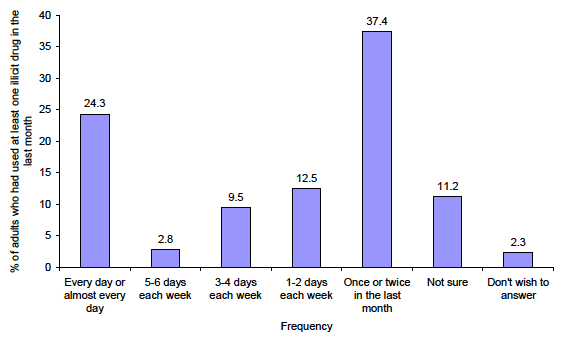
There was variation by socio-economic group and tenure. Adults who were not working or long term unemployed using drugs in the last month (37.1%) were significantly more likely to have taken their most frequently used drug every day or almost every day compared with the average for all adults (24.3%).
Adults living in privately rented accommodation using drugs in the last month (13.0%) were significantly less likely to have taken their most frequently used drug every day or almost every day compared with the average for all adults (24.3%).
3.5.2 Drug dependency
Two questions relating to dependency on the drug used most often were asked of those who had taken any illicit drug in the last month.[27]
First, those who had used at least one illicit drug in the last month were asked whether, in the last month, they had felt dependent on the drug they used most often in that period. Almost a quarter (24.4%) reported they had felt dependent on the drug they used most often in the last month while over seven in ten (73.7%) said they had not.[28]
- Almost one in five (19.6%) of those who had used at least one illicit drug in the last month said they felt dependent on or needed to take cannabis in that period;
- 0.8% of those who had used at least one illicit drug in the last month reported feeling dependent on any stimulant drug in that period. This included 0.4% on amphetamine and 0.4% reporting that they felt dependent on cocaine in the last month. No adults among those who had used at least one illicit drug in the last month reported feeling dependent on ecstasy, crack or poppers in that period;
- 1.3% of those who had used at least one illicit drug in the last month reported feeling dependent on any downer / tranquiliser in that period, including 1.1% saying they felt dependent on valium and 0.2% on temazepam in the last month;
- No adults among those who had used at least one illicit drug in the last month reported feeling dependent on any of the psychedelic drugs in that period;
- 2.4% of those who had used at least one illicit drug in the last month reported feeling dependent on any opiate in that period including 1.5% saying they felt dependent on methadone and 0.9% on heroin in the last month;
- 0.4% of those who had used at least one illicit drug in the last month reported feeling dependent on anabolic steroids. No adults who had said they had felt dependent on glues, solvents, gas or aerosols in that period.
Those who had used at least one illicit drug in the last month were also asked whether in the last month they had tried to cut down on the drug they used most often in that period, but found they could not. Three in ten (29.7%) said they had tried to cut down on their use of the drug they used most often in the last month, but found they could not, while over two thirds (67.3%) said they had not tried to cut down.
- More than one in five (23.5%) of those using at least one illicit drug in the last month reported that they had tried to cut down on their cannabis intake in the last month, but found that they could not;
- One in thirty one (3.2%) of those taking drugs in the last month had tried to cut down on any stimulant drug in that period including 1.4% who had tried but found they could not cut down on their cocaine use, 0.8% their amphetamine use, 0.6% their ecstasy use and 0.3% their use of crack. No adults reported that they had tried but were unable to cut down on their use of poppers;
- Of those using at least one illicit drug in the last month, 0.7% said they had tried but found they could not cut down on downers / tranquilisers including 0.5% who had tried and were unable to cut down on valium and 0.2% on temazepam in the last month;
- No adults among those who had used at least one illicit drug in the last month said they had tried to cut down on their use of any psychedelic drug but found they could not in that period;
- Among those who had used at least one illicit drug in the last month 1.8% said they had tried to cut down on their use of any opiate but had not been able to. This included 0.9% who had tried and found they could not cut down on heroin and 0.8% on methadone;
- 0.5% of those who had used at least one illicit drug in the last month said they had tried to cut down on their use of anabolic steroids. No adults reported that they had tried to cut down on glues, solvents, gas or aerosols and were not able to in that period.
As well as analysing the two questions separately, the percentage saying yes to either question, and to both, was also investigated. This showed that just over four in ten (41.4%) of those who had taken at least one illicit drug in the last month had, in that period, either felt dependent on the drug they used most often in the last month and / or had tried and found they were unable to cut down on it. Around one in eight (12.7%) adults who had used an illicit drug in the last month had, in that period, felt dependent on the drug they used most often in the last month and had tried to and found they could not cut down on it.
3.5.3 Ease of obtaining drugs in the last month
Those who reported taking any drug in the last month were asked how difficult it was for them to get hold of the drug they had used most often in the last month.
Of those adults who had used any drug in the last month, the majority (78.5%) reported that it was easy to get hold of the drug they had used most often in the last month, including 39.2% who said it was very easy (Figure 3.4).
Figure 3.4 displays how difficult it was for those using at least one illicit drug in the last month to obtain the drug they used most often in that period over time.
- In the SCJS 2010/11, 78.5% of those using at least one illicit drug in the last month reported that it was fairly or very easy to get hold of the drug they reported using most often in that period. This percentage has fallen when compared to the SCJS 2009/10 (83.4%) and the SCJS 2008/09 (87.6%):
- Fewer respondents reported that it was very easy to obtain the drug they used most often in the last month in 2010/11 (39.2%) compared to in 2008/09 and 2009/10 (48.6% and 46.1% respectively);
- In the SCJS 2010/11, one in five (20.6%) of those using at least one drug in the last month said it was very or fairly difficult to get hold of the drug they used most often in that period, compared with 15.6% in the SCJS 2009/10 and 11.8% in the SCJS 2008/09:
- A similar percentage said it was very difficult to obtain the drug they used most often in the last month in the SCJS 2010/11 (3.7%) compared with the SCJS 2009/10 (3.7%) and the SCJS 2008/09 (2.4%).
Figure 3.4: Ease of getting hold of drug used most often in the last month
SCJS 2008/09; SCJS 2009/10; SCJS 2010/11.
Base: Adults aged 16 or over who had used as least one illicit drug in the last month (2008/09 384; 2009/10 436; 2010/11 308).
Variable name: QDRHOLD.
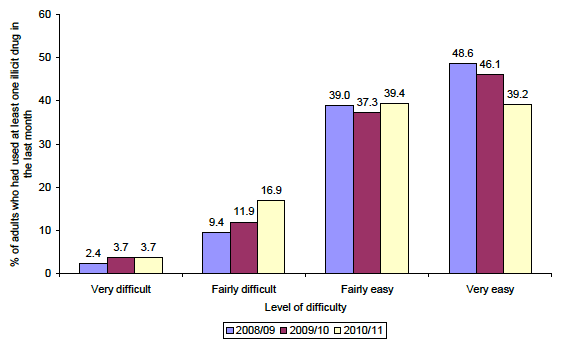
Polydrug use is the use of more than one drug at the same time, often with the intention of enhancing or countering the effect of another drug. Polydrug use is distinct from multiple drug use, where users may be taking more than one type of drug over a particular period (Brown and Bolling, 2007). Polydrug use is a particular concern because of the increased risk to both mental and physical wellbeing, including the risk of overdose due to the interactions between drugs, as well as the use of unfamiliar drugs (Hoare, 2010).
Respondents who had used at least one illicit drug in the last month (3.5% of adults) were asked if they had ever used another drug when they were under the influence of the drug they had used most often in the last month:
- Over a third (34.3%) of these adults reported some kind of polydrug use.
Over seven in ten (73.0%) of those who had ever mixed the drug they used most often in the last month with any other drug, had mixed other drugs with cannabis, reflecting the predominance of cannabis as the drug used most often in the last month (section 3.4). Almost a third (31.3%) of those who had used cannabis most often in the last month had mixed it with one or more other drugs.
The drugs that these adults said they had ever mixed with the drug they took most often in the last month are shown in Figure 3.5. This shows that:
- The types of drugs these adults were most likely to have ever mixed with the drug they used most often in the last month were stimulants (83.7%), in particular ecstasy (52.5%), cocaine (50.0%) or amphetamines (37.4%);
- Three in ten of those adults reporting polydrug use (35.4%) had ever mixed the drug they had used most often in the last month with psychedelics, principally with magic mushrooms (23.0%);
- Three in ten (34.3%) had ever mixed the drug they had used most often in the last month with downers / tranquilisers, principally with valium (34.3%);
- One in six (16.5%) adults reporting polydrug use reported that they had ever mixed the drug they had used most often in the last month with cannabis.
Figure 3.5: Drugs ever mixed with drug used most often in the last month - most often mixed drugs [29]
SCJS 2010/11.
Base: Adults aged 16 or over who had ever mixed the drug used most often in the last month with other drugs (117).
Variable name: QDRWHIC.
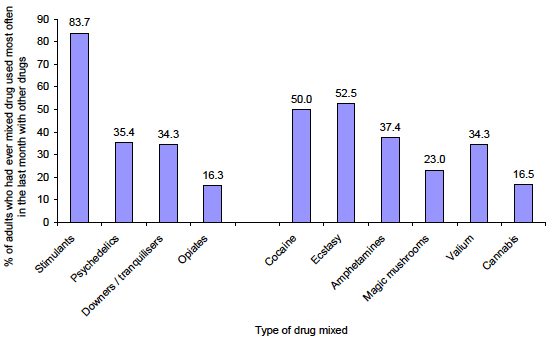
3.5.5 Mixing alcohol with the drug used most often in the last month
Of the 3.5% of adults who had used at least one illicit drug in the last month, the majority (84.6%) also reported drinking alcohol at some point in their lives while under the influence of the drug they had used most often in the last month. This compares with 34.3% who reported ever mixing the drug they had used most often in the last month with other drugs as seen in section 3.5.4 (Figure 3.6).
Figure 3.6: % ever mixing drug used most often in the last month with other drugs or alcohol by gender
SCJS 2010/11.
Base: Adults aged 16 or over who had used at least one illicit drug in the last month (308).
Variable name: QDRMIX; QDRALC.
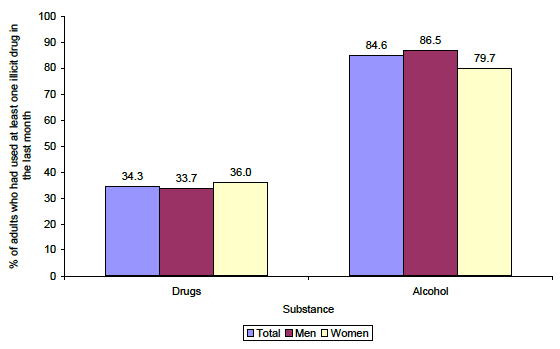
3.6 Experience of drug use ever
Having examined drug use in the last year and in the last month, this chapter concludes by considering aspects of drug taking among those adults who reported using drugs at some point in their lives. This includes the age at which they took their first drug, the drug they first used and the method(s) of drug taking they had ever tried.
3.6.1 Age at which drugs were first taken
All adults who reported that they had ever used one or more illicit drug were asked at what age they first took drugs (Figure 3.7).
- Late teens (16-19 years) was the most common age for first trying drugs, with over half (51.3%) of those who had used drugs at some point in their lives first trying them at this age;
- Of those adults who had used drugs at some point in their lives, a quarter (24.7%) reported that they had first tried them when they were under 16.
Figure 3.7: Age at which drugs were first taken
SCJS 2010/11.
Base: Adults aged 16 or over who had ever used at least one illicit drug (2,350).
Variable name: QDRAGE.
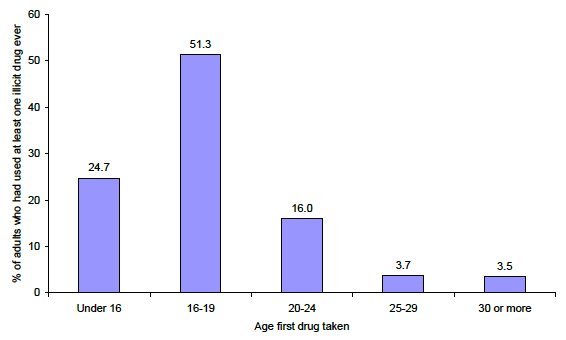
- Men who had ever used any drug were significantly more likely to have first tried any drug when they were under 16 (27.0%) compared with women (21.4%);
- Those who had ever used any drug who were living in social rented accommodation at the time of the survey interview (36.0%) were significantly more likely to have first tried any drug when they were under 16 compared with those living in private rented accommodation (23.1%) and owner-occupiers (19.8%);
- Adults who had ever used drugs living in the 15% most deprived areas of Scotland were significantly more likely to have first tried any drug when they were under 16 (37.9% compared with 22.2% of those living in the rest of Scotland);
- Adults who were not working or who were long term unemployed at the time of the survey interview were significantly more likely to have first tried any drug when they were under 16 (30.9%) compared to the average for all adults (24.7%).
3.6.2 First drug ever used
Respondents who had ever used one or more illicit drug were also asked to indicate the drug they first took. Their responses are shown below in Figure 3.8, which is ranked in order of the drugs most commonly used ever.
- More than three quarters (78.3%) of adults who had ever used any illicit drug reported that cannabis was the first drug that they tried;
- Over one in ten (11.4%) of those who had ever taken any illicit drug reported first taking any stimulant with 4.0% first taking amphetamines, 3.8% mentioning poppers, 2.7% ecstasy and 0.9% cocaine;
- 4.1% of those using illicit drugs ever had first used a psychedelic drug including magic mushrooms (2.2%), LSD (1.6%) and ketamine (0.3%);
- 2.5% of those who had ever taken any illicit drug reported first taking downers / tranquilisers including 1.7% first taking valium and 0.8% first taking temazepam;
- 2.5% of those who had ever taken any illicit drug had first taken glues, solvents, gas or aerosols;
- 0.2% of those who had ever taken any illicit drug reported first taking an opiate, including 0.1% who reported first taking heroin.
Figure 3.8: First drug ever used [30]
SCJS 2010/11.
Base: Adults aged 16 or over who had ever used at least one illicit drug (2,350).
Variable name: QDR1ST.
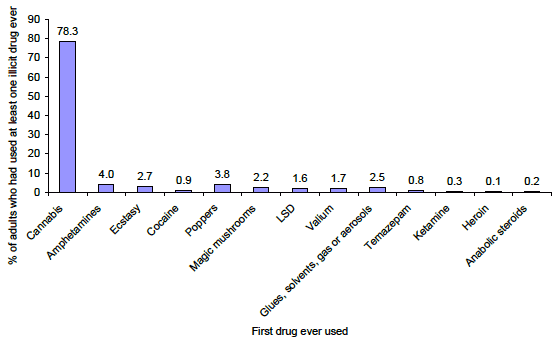
The dominance of cannabis as the first drug used was maintained regardless of the age at which an adult took their first drug.
The percentage of adults taking some other drugs first varied depending on the age at which they were first taken:
- For adults who took their first drug when they were under 16, a higher percentage reported that the first drug they used was glues, solvents, gas or aerosols among both men (9.9% compared with 3.0% of men who had ever taken any drug on average) and women (7.6% compared with 1.7% of women who had ever taken any drug on average). This suggests that illicit drugs are possibly less available to those under the age of 16 meaning that they are more likely to try substances more readily available to them;
- For adults, who reported first using drugs when they were 25 and over, a higher percentage reported that the first illicit drug that they took was a downer / tranquiliser (12.7% compared with 2.5% of all adults):
- o Among women who took their first drug aged 25 or over, 16.3% said the first drug they took was valium compared with 3.3% of all women who had ever taken any drug whose first drug taken was valium;
3.6.3 Methods of taking drugs ever tried
Of those adults who reported that they had used illicit drugs at some point in their lives, the majority (90.3%), said that they had taken them by smoking, sniffing or inhaling them.
However, two in five (40.2%) adults also reported that they had tried swallowing, eating or drinking drugs.
Just 1.8% of adults, aged 16 and over, who had used drugs at some point in their lives reported that they had injected them.[31]
Contact
Email: Stuart King
There is a problem
Thanks for your feedback